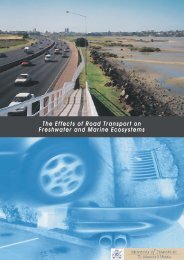Auckland City Centre Rail Link - Business Case Review - Ministry of ...
Auckland City Centre Rail Link - Business Case Review - Ministry of ...
Auckland City Centre Rail Link - Business Case Review - Ministry of ...
You also want an ePaper? Increase the reach of your titles
YUMPU automatically turns print PDFs into web optimized ePapers that Google loves.
<strong>Auckland</strong> <strong>City</strong> <strong>Centre</strong> <strong>Rail</strong> <strong>Link</strong> <strong>Business</strong> <strong>Case</strong> <strong>Review</strong> | May 2011<br />
structure. This results in faster economic growth, increasing the size <strong>of</strong> the regional<br />
economy. This effect is discussed in regards to projects <strong>of</strong> comparable size and<br />
significance in the report Roads <strong>of</strong> National Significance Economic Assessments<br />
<strong>Review</strong> prepared by SAHA for the NZTA noting that roads contribute directly to<br />
economic growth. The Additional Waitemata Harbour Crossing Preliminary <strong>Business</strong><br />
<strong>Case</strong> shows that even small increases in the size <strong>of</strong> the regional economy from<br />
transport infrastructure can have significant effects in relation to the benefits <strong>of</strong> a<br />
project. Importantly, the calculation <strong>of</strong> all other benefits would be applied across a<br />
larger base with respect to both the agglomeration and increased productivity effects.<br />
Conventional market analysis does not capture these effects and an increase in the<br />
size <strong>of</strong> the regional economy, in our view, has not been captured in the rail loop<br />
business case. We agree with the statements made by several leading economic<br />
consultancies (including Infometrics, NZIER 24 and Market Economics) that economic<br />
assessment <strong>of</strong> major transport or other infrastructure need to take into account the<br />
likely effects on the size and growth rate <strong>of</strong> the economy. Otherwise, the effects are<br />
likely to be under-stated, because direct transport effects, agglomeration effects and<br />
productivity gains will be calculated using estimates <strong>of</strong> the business sector, labour<br />
force and population, which underestimate the likely outcomes.<br />
This is important for major projects such as the CCRL with region-wide benefits,<br />
because a significant share <strong>of</strong> the economic benefit is likely to arise because the<br />
economy as a whole benefits (grows faster) from efficiency gains. Conversely,<br />
excluding the economy-wide effects will almost certainly act to understate effects<br />
(benefits and costs) for the economic evaluation. Where a project is being evaluated<br />
using a standard BCR approach, then the BCR is likely to be correspondingly understated.<br />
There has been no allowance for the additional benefits and costs associated with<br />
the larger economy in the economic assessments for the CCRL, which would appear<br />
a significant omission. Therefore, <strong>Auckland</strong> Council <strong>of</strong>ficers believe the BCR is<br />
understated.<br />
The following points help to set this in context for the CCRL.<br />
i. The <strong>Business</strong> <strong>Case</strong> identified transport benefits <strong>of</strong> $1.319 billion over 30 years<br />
(at an eight percent discount rate), and wider benefits (mainly agglomeration) <strong>of</strong><br />
$0.184 billion, totalling $1.503 billion.<br />
ii.<br />
iii.<br />
By 2021 (first year <strong>of</strong> rail operation) the <strong>Auckland</strong> economy would be around<br />
$71 billion (VA). If the project generated an increase <strong>of</strong> 0.36 percent in the<br />
<strong>Auckland</strong> economy 25 , this would amount to around $1.3 billion in NPV terms<br />
(same period, same discount rate, excluding the direct construction impact).<br />
If a component 26 <strong>of</strong> this economy-wide effect were acknowledged, then it would<br />
materially alter the BCR calculation. This is not to equate value added and<br />
benefit, but to recognise that relatively small percentage effects across a large<br />
economy for an extended time period may be significant in relation to the<br />
project, and that some share <strong>of</strong> such effects does constitute a ‗benefit‘.<br />
24 NZIER, 2011: Reprioritising infrastructure projects, NZIER Insight 26, 8 March 2011.<br />
25<br />
Based on the indicative figure in the AWHC study.<br />
26 Value added does not equate to benefit, though benefit is a component <strong>of</strong> value added.<br />
The prospect <strong>of</strong> effects across the economy appears to be one key reason for distinguishing<br />
and prioritizing RoNS relative to other projects.<br />
42
















